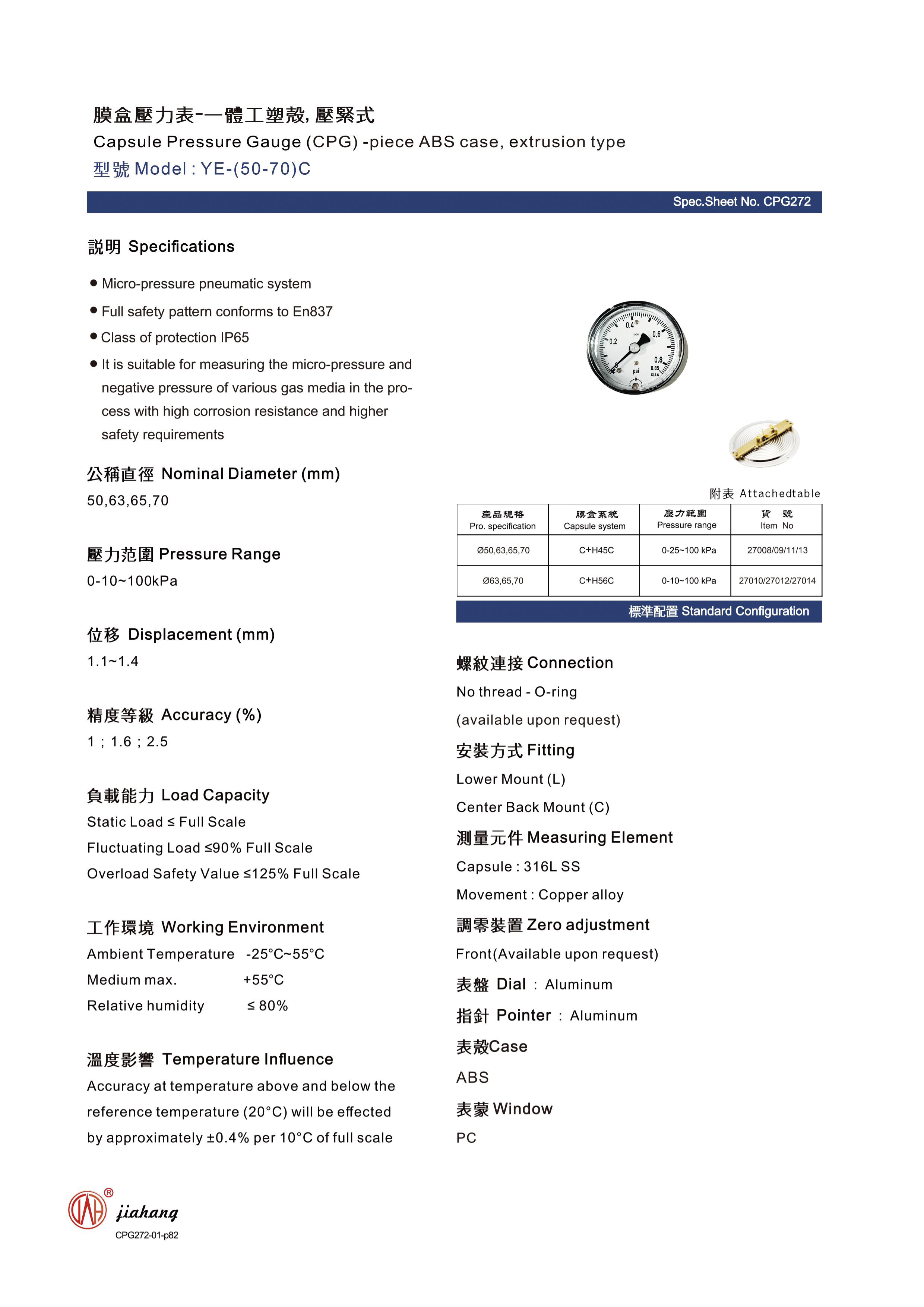
Dec . 10, 2024 22:58 Back to list
Various Types of OEM Differential Pressure Gauges for Accurate Measurements
Understanding OEM Differential Pressure Gauge Types
Differential pressure gauges are essential instruments used in various industrial applications to measure the difference in pressure between two points. These devices are particularly critical in processes where monitoring fluid flow, filter conditions, and system performance are vital. OEM (Original Equipment Manufacturer) differential pressure gauges are designed specifically for integration into broader systems, ensuring compatibility and precision. In this article, we will explore the types of OEM differential pressure gauges, their applications, and their significance in modern industry.
Types of OEM Differential Pressure Gauges
1. Mechanical Differential Pressure Gauges Mechanical gauges operate on the principle of elastic deformation. These gauges typically use a diaphragm or capsule that deflects when there is a pressure difference between the two points being measured. The deformation is translated into a mechanical movement that indicates the pressure difference on a dial. Mechanical differential pressure gauges are robust, simple, and do not require external power. They are ideal for various applications, including water treatment, HVAC systems, and process manufacturing.
2. Electronic Differential Pressure Gauges Unlike mechanical types, electronic differential pressure gauges use sensors to measure pressure differences. These sensors can be based on various technologies, including capacitive, piezoresistive, and strain gauge principles. The measured data is converted into an electrical signal, which can be displayed digitally or transmitted to control systems. Electronic gauges offer higher accuracy and the ability to integrate with data logging systems, making them suitable for advanced monitoring and automation applications in industries such as pharmaceuticals, oil and gas, and semiconductor manufacturing.
3. Digital Differential Pressure Gauges Digital differential pressure gauges combine electronic measurement techniques with digital display technologies. These gauges often come equipped with features such as backlit screens, data logging capabilities, and communication interfaces like Bluetooth or RS-485. This allows users to monitor pressure in real time and even configure settings remotely. Digital gauges are particularly useful in cleanroom environments and laboratories where precision is critical, and the ease of data visualization enhances process oversight.
4. Analog Differential Pressure Gauges Analog gauges employ traditional needle and dial mechanisms to present pressure readings. While they may not offer the advanced features of digital gauges, they are appreciated for their simplicity and reliability. Analog differential pressure gauges are often used in applications where quick visual assessments are needed, such as in HVAC systems or in situations where electronic devices may be prone to failure due to environmental factors.
oem differential pressure gauge types

5. Wireless Differential Pressure Gauges The increasing adoption of wireless technology in industrial applications has led to the development of wireless differential pressure gauges. These gauges transmit pressure readings wirelessly to a central monitoring system, allowing for remote surveillance and data analysis. Wireless solutions are beneficial in hard-to-reach locations or in systems where wiring would be challenging to implement. They find applications in wastewater treatment, environmental monitoring, and civil infrastructure.
Applications and Importance
The choice of differential pressure gauge typically depends on the specific application and operational requirements. For instance, in the HVAC industry, differential pressure gauges are used to monitor airflow and filter conditions, ensuring efficient operation and maintenance of air systems. In the oil and gas sector, these gauges help prevent equipment failures by monitoring the pressure conditions within pipelines and wells. Additionally, in pharmaceutical manufacturing, maintaining accurate pressure differentials is crucial to meet stringent regulations and ensure product integrity.
Furthermore, OEM differential pressure gauges contribute to the automation of processes. By providing accurate and timely data, these gauges enable real-time decision-making, improve efficiency, and reduce the risk of costly failures. With the growing push towards Industry 4.0, the integration of smart differential pressure gauges into automated systems is expected to enhance productivity and operational transparency.
Conclusion
OEM differential pressure gauges play a pivotal role in various industrial applications by providing essential measurements that contribute to efficient and safe operations. Understanding the types of gauges available—mechanical, electronic, digital, analog, and wireless—helps industries choose the right tool for their specific needs. As technology advances, the evolution of differential pressure gauges will continue to play a critical role in optimizing processes across a multitude of sectors, ensuring they meet the demands of an increasingly automated and data-driven world.
-
HD Fire Pressure Gauges High Accuracy & Durable Solutions
NewsMay.28,2025
-
Custom Singles Capsule Systems Top Exporters & Factories
NewsMay.28,2025
-
Piston-Style Differential Pressure Gauges Precision & Durability
NewsMay.28,2025
-
WIKA Differential Pressure Gauge 700.04 High-Accuracy Industrial Measurement
NewsMay.28,2025
-
Precision Differential Pressure Gauge Factory Custom Solutions & OEM Services
NewsMay.27,2025
-
Pressure Diaphragm Capsule Elements High-Accuracy & Durable Solutions
NewsMay.27,2025
